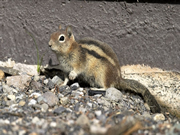General Mole Questions
Q. Why did the Creator of Heaven and Earth make moles, anyway?
Q. Why did the moles pick my yard?
Q. Why do moles want to live in my yard?
Q. Why do I need to get rid of moles?
Q. When do moles come into houses?
Q. When is the best time to get rid of moles?
Q. How do I know if I have moles in my yard?
Q. Where can I get help with my mole problem?
Health & Safety
Q. What are the health risks of having moles on my property?
Q. Who is responsible for this mole problem?
Animal Control Products and Methods
Q. What are the most common mole complaints you receive?
Q. Which poisons do you recommend to kill moles?
Q. Which mole repellents are the best?
Q. Which methods do you use to exterminate moles?
Q. Who should I call for help?
Q. Why should I hire a professional to get rid of moles?
Property Damage
Q. What damage can moles cause?
Q. What is this going to do to my property value?
Q. How can I get the moles out?
Q. How can a wildlife removal technician help me get rid of the moles?
Costs
Q. What does it cost for an initial on-site mole inspection?
Q. What does it cost for an initial over-the-phone mole control consultation?
Q. Who pays for my mole problem?
Q. What FREE mole control services does your company offer to the public?
Q. How much will it cost to get rid of the moles?
General Mole Questions
Q. Why did the Creator of Heaven and Earth make moles, anyway?
A. Moles are insectivores, similar to bats. A mole eats 70-80% of its weight in insects every day. This is because they burn so much energy digging. In addition to consuming pest insects, they aerate the soil as they tunnel. Pretty cool, as long as they aren't in your yard.
Q. Why did the moles pick my yard?
A. Moles like bugs and easy digging in moist and cool soil. I would guess your yard is beautiful with great dirt you have worked a long time to make nice.and now the moles know it. Sorry about that, but you are not alone. Moles are one of the most common pest animals and shady parks, well-watered golf courses and lush yards are favorite spots.
Q. Why do moles want to live in my yard?
A. Moles want to live in your yard because food is available there and moles need a lot of it. They like worms (which you like, too) and grubs and beetle larvae (which you will probably be less happy to hear). They will create extensive runways under the entirety of your lawn, searching for and consuming food.
Q. Why do I need to get rid of moles?
A. You need to get rid of the moles or they will quickly get rid of all of your favorite plants and trees. Active moles, and they are active more or less year round, may be looking for worms and grubs to eat, but in the process they turn grass brown, create low and weak spots in your yards and create the famous molehills of disturbed dirt. Their tunnels are more like labyrinths and soon become homes for mice and snakes, which aren't any more welcome than the moles.
A. Moles are a problem as their molehills become mountains in yards, golf courses and other landscaped areas. As they search for food they kill grass and expensive landscaping plants and shrubs and make the ground uneven and unsightly.
Q. When do moles come into houses?
A. Moles rarely enter buildings of any kind. There isn't dirt for tunneling or bugs for eating. Occasionally, one may end up inside due to a tunnel gone wrong, but outside and underground is where a mole wants to be.
Q. When is the best time to get rid of moles?
A. As moles are active year-round, any time is a good time to get rid of moles. Right away and before they have babies is the very best time of all.
A. Moles live underground, preferably in moist and sandy soil. They are found over much of the Eastern United States. They naturally exist in forests or woodlands but have moved into all kinds of urban and suburban environments from yards to golf courses to cemeteries.
Q. How do I know if I have moles in my yard?
A. You will start to notice molehills. These are conical, or volcano shaped. Plants start to mysteriously die and grass, too. The dead grass will have an unusual pattern, like lightning bolts or a road map. Sometimes there will be low spots like a giant footprint, created by a void underneath. Don't expect to see the mole; that would be very unusual. But it is there, undermining your yard.
Q. Where can I get help with my mole problem?
A. Allstate Mole Control can help you. We are familiar with the secretive lives of moles and know how to get rid of them. Hire a professional wild pest animal removal company like us.
Health & Safety
Q. What are the health risks of having moles on my property?
A. Moles do carry rabies, but direct contact with humans is rare. More often, pets might be injured trying to dig out a mole or by catching one above ground at night.
A. Moles may be a nuisance, but they are not dangerous. If you do find a mole above ground and it doesn't try to dig away from you, do not touch it. It is almost certainly sick.
Q. Who is responsible for this mole problem?
A. The lawn grubs are responsible, but we will be glad to help you deal with the problem. As property owner, you are now made responsible for getting rid of the pest animal on your property. Call Allstate Mole Control and we will help you.
Animal Control Products and Methods
Q. What are the most common mole complaints you receive?
A. Moles tunnel, leaving molehills, ridges of dirt and depressions of dead grass all over a previously beautiful lawn. They ruin expensive landscaping and make lawn care difficult.
Q. Which poisons do you recommend to kill moles?
A. Poisons are not generally effective against moles as they will not consume them.
Q. Which mole repellents are the best?
A. There are no long-term effective chemical repellents for moles.
Q. Which methods do you use to exterminate moles?
A. Depending on state and local regulations, we usually trap moles. This is the most effective form of removal.
Q. Who should I call for help?
A. Call Allstate Mole Control . We have helped many people get rid of moles from lawns, golf courses and farms. Our services are effective and we have the experience and expertise you need.
Q. Why should I hire a professional to get rid of moles?
A. Moles are difficult to get rid of unless you have extensive experience and expertise in mole removal. A professional will handle the problem quickly and without further damage to your property.
Property Damage
Q. What damage can moles cause?
A. Moles burrow in gardens, lawns, fields and golf courses. They create molehills, which are unsightly. The tunnels can be dangerous and are always unattractive as they form a sort of confused looking brown roadmap of dead grass in the turf. The moles are not after your plants; they eat insects. The plants, however, get in the way of these digging machines and become collateral damage. Moles do not hibernate and go right on tunneling and damaging things year round.
Q. What is this going to do to my property value?
A. Mole damage is usually superficial and makes a property less attractive.
Q. How can I get the moles out?
A. You can find a lot of information on homemade mole remedies. None of them work. Here is a list of some of the popular, and sadly ineffective, methods: kitty litter in the tunnels; crushed glass in the tunnels; mothball powder in the tunnels; Wrigley's Spearmint Gum, chewed or unchewed. It might make you feel better that you are "doing something about the moles" but these will cost you time and money without doing much about the moles. Trapping is the only method proven effective for getting rid of these animals.
Q. How can a wildlife removal technician help me get rid of the moles?
A. Professional wildlife removal technicians, like those in our network, know what works. We have worked with moles many times and understand their unique behavior. We can get rid of your moles too, and share our knowledge about moles to keep them away from your property in the future.
Costs
Q. What does it cost for an initial on-site mole inspection?
A. Inspections start at $150-250, depending on your location. For specific information, see our Mole Removal Pricing.
Q. What does it cost for an initial over-the-phone mole control consultation?
A . FREE! Send 5-10 pictures via e-mail and we will review them and call you to recommend a solution and give you an estimate. Pictures should include suspected molehills and tunnels, damage caused by the moles, and any related items you think might be important.
Q. Who pays for my mole problem?
A. Mole infestations are the responsibility of the property owner. Typically mole removal starts with an inspection and evaluation which costs $150-250, depending on your location. You may want to contact your property insurance carrier; your policy may include coverage for removal and clean up of pest animals. For specific information, see our Pricing Page.
Q. What FREE mole control services does your company offer to the public?
A. If you find a suspected mole problem on your property, take 5-10 digital pictures and e-mail them to us (use the Contact Us page). We will call you on the phone and discuss your situation for a few minutes and suggest a plan of action, as time allows.
Q. How much will it cost to get rid of the moles?
A. Prices vary depending on your location, number of animals and severity of the problem. I can give you a FREE estimate over the phone using digital pictures you e-mail me. For additional information, see our Mole Pricing Page.
Common Mole Myths and Interesting Trivia:
Myth: Moles are rodents, like voles and rats.
Fact: The mole discussed here is usually referred to as the eastern mole ( Scalopus aquaticus ). It is an insectivore, not a rodent, and is related to shrews and bats.

 1-888-488-7720
1-888-488-7720
































